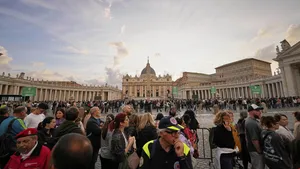TRACING HISTORY
Dead in ‘Perdikan’ Land
The past was filled with a glorious story about a vast tea plantation on the southeastern slope of Mount Wilis in East Java. But then, times changed and it came to an end.
/https%3A%2F%2Fkompas.id%2Fwp-content%2Fuploads%2F2020%2F03%2F20200303_ENGLISH-EKPEDISI-TEH_C_web_1583245349.jpg)
Workers pick tea leaves at the Teh Sirah Kencong plantation in Blitar, East Java, on Monday (29/7/2019). A shortage of young people interested in picking tea leaves for a living is one of the problems faced by tea plantations throughout the archipelago. Apart from low wages, the young generation also considers picking tea a tiring job when compared to working at a factory.
It is the end of July 2019 on the southeastern slope of Mount Wilis. Standing atop one ridge is Penampihan Temple. Occupying an area about twice the size of a volleyball court, the ancient temple has undergone several modifications and its function has transformed over the years from the megalithic period through the Hindu Mataram, Khadiri, Singhasari and to the Majapahit eras.
A tinulad (copied Inscription) at the site of Penampihan Temple records that the ancient Mataram king, Dyah Balitung, designated the southeastern slope of Mount Wilis as perdikan (autonomous area) in 898 and named Penampihan or Penampean. The area now belongs under the administrative jursidiction of Geger village in Sendang district, in the Tulungagung regency of East Java.
Versi cetak artikel ini terbit di harian Kompas edisi di halaman 17 dengan judul "Mati di Tanah Perdikan".
Baca Epaper Kompas




